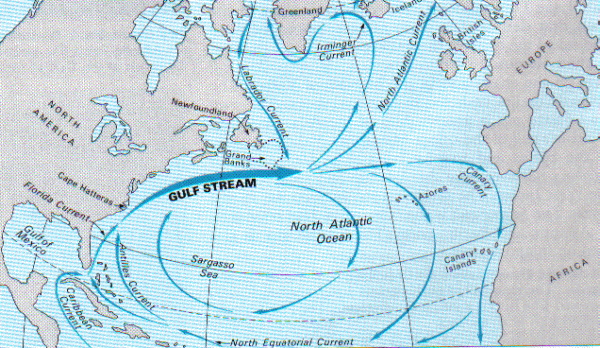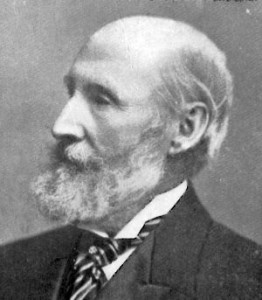Edward Hull
Gulf Stream *
The Gulf Stream was first identified in 1513 by Juan Ponce de León. It is a critical feature of the North Atlantic that is responsible for keeping the climate North-West Europe warmer than its counterpart at the same latitude of North America. However, it is wrong to assume that this benign feature has functioned permanently.
 In 1955 Professor E.F. Hagemeister of Tallin, in Estonia, published her view that based on the disintegration of ionium, an isotope of thorium, at various depths in the Atlantic, she believed that the Gulf Stream came into existence (again) around 10,000 BC. She believed that this event, the sinking of Atlantis and the ending of the last Ice Age were interrelated and that all took place around the same time.(d)
In 1955 Professor E.F. Hagemeister of Tallin, in Estonia, published her view that based on the disintegration of ionium, an isotope of thorium, at various depths in the Atlantic, she believed that the Gulf Stream came into existence (again) around 10,000 BC. She believed that this event, the sinking of Atlantis and the ending of the last Ice Age were interrelated and that all took place around the same time.(d)
It is generally accepted that during the last Ice Age the glaciation reached as far south as London. Otto Muck contended[098] that this would not have happened if the Gulf Stream had been functioning as it is today. His argument is that something had blocked its path and that the ’something’ was Atlantis. An early proponent of this idea was Edward Hull. Andrew Tomas advanced a similar notion a few years before Muck[348]. Wolter Smit, who is a keen student of Muck’s ideas, supports his views on the Gulf Stream(b). This idea was also adopted by Prescott Rawlings in his recent book, Atlantis, the Great Flood and the Asteroid[763]. Nevertheless, a 2016 report(c) from CAGE (Center for Arctic Gas Hydrate, Climate and Environment) offers evidence that the Gulf Stream was not cut off during the Ice Age.
Another view was expressed in a New Scientist article in 2007, which proposed that the bursting of a glacial lake in Canada, 8,000 years ago, dumped an estimated 100,000 cubic kilometres of water into the North Atlantic, shutting down the Gulf Stream.(e)
Gradually, evidence has been emerging that the progressive melting of the Greenland ice sheet may cause the Gulf Stream to shut down again. In 2005 data has been gathered which shows that the efficiency of the Gulf Stream has been reduced by 30% in the past 50 years and generated speculation that the Gulf Stream could shut off within ‘decades’. Such a disastrous event would, of course, seriously undermine Muck’s hypothesis, as it would demonstrate that a mid-Atlantic Atlantis was not required to generate an Ice Age. Furthermore, the Gulf Stream’s ability to absorb CO2 has also been halved(a) between 1996 and 2005.
In May 2010 the Gulf Stream briefly shutdown once again without the need for an Atlantis to cause it. At last, there appears to be a greater appreciation of the number of elements that can interfere with the flow of the Gulf Stream, such as global warming, reduced salinity(f) and geological heat flow(g).
(b) https://en.was-this-atlantis.info/gulf-stream.html
(c) https://www.sciencedaily.com/releases/2016/02/160219134816.htm
(d) https://web.archive.org/web/20091020233311/http://geocities.com/MotorCity/Factory/2583/morley.htm
(e) https://www.newscientist.com/article/dn13013-ancient-flood-brought-gulf-stream-to-a-halt/
(g) http://www.plateclimatology.com/gulf-stream-shut-down-caused-by-geological-heat-flow
Hull, Edward *
Edward Hull (1829-1917) was a famous Irish geologist who worked for the British Geological Survey for 41 years until 1891. He was Director of the Geological Survey of Ireland from 1868 and a Professor at the Dublin Royal College of Sciences. He published his memoirs in 1910 [406]+.
Ireland from 1868 and a Professor at the Dublin Royal College of Sciences. He published his memoirs in 1910 [406]+.
Hull identified the Azores as possible remnants of Atlantis following the rising of sea levels around 9000 or 10000 BC. He commented(b) “The tradition of Atlantis ‘beyond the Pillars of Hercules’ can scarcely be supposed to have originated in the mind of man without a basis of reality”.
Hull believed that Atlantis in the Atlantic deflected the Gulf Stream leading to the onset of the last Ice Age! It was over half a century before the idea was revived by other researchers such as Tomas and Muck.
In 1890 he drew a famous time chart some fifteen feet long, based on the 1650 biblical dating system[1681] of another Irishman, Dublin-born James Ussher, Church of Ireland Archbishop of Armagh (1625-1656). What is strange about this is that while Ussher dated the beginning of the world to 4004 BC, Hull’s own writings were based on more scientific data. This same chart has been republished more recently by Barnes & Noble(c) and updated in a manner that has horrified creationists.
However, it should be noted that Sebastian C. Adams (1825-1898) published a comparable wall chart in 1871(a), so it appears that the original concept was Adams’.
[0406]+ https://babel.hathitrust.org/cgi/pt?id=inu.39000025091393;view=1up;seq=12
(a) https://www.masterbooks.com/adams-chart-of-history-unbound-version-single
(b) London Budget, 1st Dec.1912
Mackenzie, Donald Alexander
 Donald Alexander Mackenzie (1873-1936) was a renowned mythologist of the early 20th century who referred to Atlantis on a number of occasions. He seemed to be inclined to place Plato’s island in the Atlantic and saw the submergence of land around the British Isles at the end of the last Ice Age as the most likely explanation[459.90].
Donald Alexander Mackenzie (1873-1936) was a renowned mythologist of the early 20th century who referred to Atlantis on a number of occasions. He seemed to be inclined to place Plato’s island in the Atlantic and saw the submergence of land around the British Isles at the end of the last Ice Age as the most likely explanation[459.90].
In the same volume he touched on the Atlantic landbridge theories of Scharff, Hull and Brasseur de Bourbourg. However, Mackenzie did accept the previous year’s Paul Schliemann hoax.
In his Myths and Traditions of the South Sea Islands,he dismisses the idea of a lost Pacific continent as existing only “in the imaginations of writers untrained in scientific method.”[1030.5]
One of his many books, Myths of Crete and Prehistoric Europe[460], which contains a chapter on the possibility of a Cretan connection with Atlantis, is available on the internet(a).
(a)https://earth-history.com/Greece/Myths/mckenzie-05.htm
